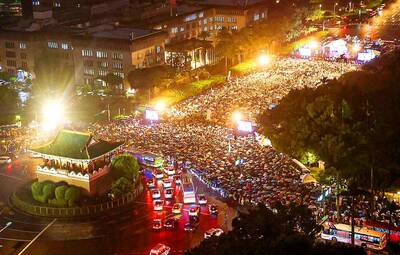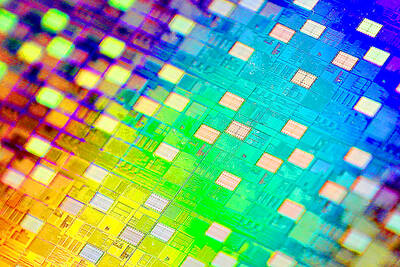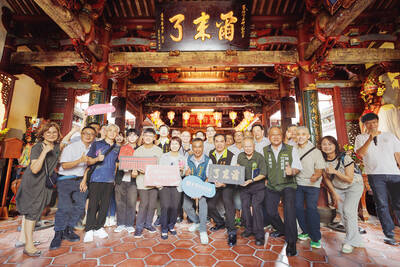The increased use of computers in recent years has caused presbyopia — a common vision condition that normally affects people over 40 years old — to be diagnosed at a younger age, an ophthalmologist said yesterday.
Presbyopia is a condition where the eye gradually loses its ability to focus on close objects.
“I now have patients in their 30s coming to me with symptoms of presbyopia,” said James Liau (廖士傑), chief of the Shu-Tien Ophthalmology Clinic.
Common symptoms include difficulty reading under low lighting, experiencing pain in the eyebrow area after reading for long periods of time and momentarily blurred vision when switching between looking at far and near objects, Liau said.
“[People with severe presbyopia] say their arms have become too short, because they must hold whatever they are reading at farther and farther distances,” he said.
While people with myopia, or nearsightedness, may not develop presbyopia until they are as old as 50, it will eventually develop as one gets older, similar to graying hair.
Various factors and habits could cause presbyopia to develop at a younger age than normal, such as hyperopia, or farsightedness, poor reading habits and using the computer for long periods of time without resting, Liau said.
The most common way of dealing with presbyopia is corrective lenses, available as eyeglasses or contact lenses.
As the condition becomes more advanced, the prescription needs to be changed in order to “catch up” with the worsening abilities of the eye, Liau said.
When presbyopia becomes severe, a method called monovision can be used, he said.
Monovision involves the patient using contact lenses to correct one eye for near vision and the other for far vision.
“The brain will automatically filter and choose the correct image perceived by both eyes,” Liau said.
However, some patients using the monovision method say they have difficulty adjusting because the method affects depth perception, making it harder to judge whether something is near or far, he said.
The US Food and Drug Administration is researching techniques to cure presbyopia through surgical techniques.
If surgical reversal of presbyopia were approved, patients would not need to wear corrective lenses, Liau said.
Even though presbyopia cannot be prevented, it can be delayed by habits such as improving reading conditions, letting the eyes rest for three minutes every 30 minutes when using computers, massaging the temples, consuming dark-colored vegetables — such as tomatoes and carrots — and wearing sunglasses to avoid ultraviolet exposure, Liau said.

The Central Weather Administration (CWA) today issued a "tsunami watch" alert after a magnitude 8.7 earthquake struck off the Kamchatka Peninsula in northeastern Russia earlier in the morning. The quake struck off the east coast of the Kamchatka Peninsula at 7:25am (Taiwan time) at a depth of about 19km, the CWA said, citing figures from the Pacific Tsunami Warning Center. The CWA's Seismological Center said preliminary assessments indicate that a tsunami could reach Taiwan's coastal areas by 1:18pm today. The CWA urged residents along the coast to stay alert and take necessary precautions as waves as high as 1m could hit the southeastern

FINAL COUNTDOWN: About 50,000 attended a pro-recall rally yesterday, while the KMT and the TPP plan to rally against the recall votes today Democracy activists, together with arts and education representatives, yesterday organized a motorcade, while thousands gathered on Ketagalan Boulevard in Taipei in the evening in support of tomorrow’s recall votes. Recall votes for 24 Chinese Nationalist Party (KMT) lawmakers and suspended Hsinchu City mayor Ann Kao (高虹安) are to be held tomorrow, while recall votes for seven other KMT lawmakers are scheduled for Aug. 23. The afternoon motorcade was led by the Spring Breeze Culture and Arts Foundation, the Tyzen Hsiao Foundation and the Friends of Lee Teng-hui Association, and was joined by delegates from the Taiwan Statebuilding Party and the Taiwan Solidarity

Instead of threatening tariffs on Taiwan-made chips, the US should try to reinforce cooperation with Taiwan on semiconductor development to take on challenges from the People’s Republic of China (PRC), a Taiwanese think tank said. The administration of US President Donald Trump has threatened to impose across-the-board import duties of 32 percent on Taiwan-made goods and levy a separate tariff on semiconductors, which Taiwan is hoping to avoid. The Research Institute for Democracy, Society, and Emerging Technology (DSET), a National Science and Technology Council think tank, said that US efforts should focus on containing China’s semiconductor rise rather than impairing Taiwan. “Without

The National Museum of Taiwan Literature is next month to hold an exhibition in Osaka, Japan, showcasing the rich and unique history of Taiwanese folklore and literature. The exhibition, which is to run from Aug. 10 to Aug. 20 at the city’s Central Public Hall, is part of the “We Taiwan” at Expo 2025 series, highlighting Taiwan’s cultural ties with the international community, National Museum of Taiwan Literature director Chen Ying-fang (陳瑩芳) said. Folklore and literature, among Taiwan’s richest cultural heritages, naturally deserve a central place in the global dialogue, Chen said. Taiwan’s folklore would be immediately apparent at the entrance of the